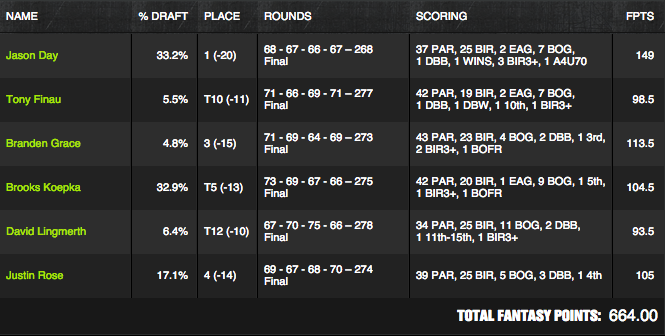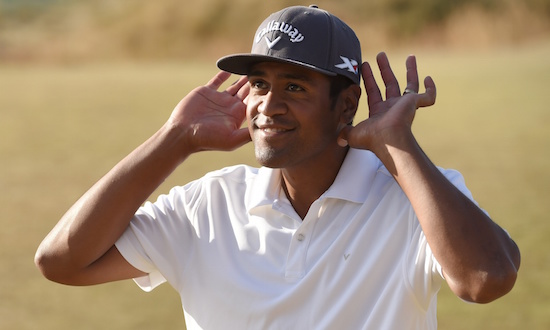Reverse Engineering: The PGA Championship
Jason Day lifted the Wanamaker Trophy on Sunday evening on the shore of Lake Michigan, taking home his first major title at the PGA Championship in record-setting fashion. The man who just a couple of months ago was lying in the rough at Chambers Bay after passing out while walking to the green on his last hole on Friday was now king of the golf world, holding off wunderkind Jordan Spieth on Sunday to win golf’s fourth major this season.
Editor’s Note: Haven’t heard? We’ve got DraftKings PGA incentives, which include full projections and expert picks from Notorious, as well as top plays from 2014 FSWA Golf Writer of the Year, Gibbathy! Expert Consensus Rankings and a Weekly Course Analysis are also included. Find out more about our incentives offerings here!
Day’s championship brings a close to golf’s major season, with the Masters not due to tee off for another eight months. That means it will likely be a while before another million dollar top prize is handed out in a PGA DFS contest, so before many players turn off their golf brains for a few months to focus on NFL and NBA, let’s take a look at how the most recent millionaire maker on DraftKings was won.

Jason Day
In order to win these large field PGA events, you almost always need the winner on your team. The only exceptions will come when the winner is under 1% owned and those few lineups don’t have the right other picks, but that doesn’t happen often, and shouldn’t impact your roster construction. To win a GPP, you need to think “Can this guy win this tournament?” and be able to answer “Yes!” for at least four or five of them.

And if you were asking yourself “Can Jason Day win this tournament?” while building lineups, you should have been saying “Yes!” Day entered the week ranked third in driving distance, which would prove to be a key factor on this very long track at Whistling Straits. He was also among the top-20 in Strokes Gained: Tee to Green, which is a stat that you must become familiar with if you play daily fantasy golf on a regular basis, as it’s one of the most predictive stats in golf. It is the SIERA or xFIP of the PGA, as it helps us figure out how well a player is doing from the tee box and the fairway/rough, without having to consider faulty metrics that might mislead us like Total Driving.
Total Driving and its components driving distance and driving accuracy have their place, but there are issues with all three statistics when it comes to predicting golf outcomes. Driving distance doesn’t take accuracy into consideration, and as we’ve seen from Tiger Woods this year, hitting it a long way doesn’t help if you wind up in some nasty rough. Driving accuracy can be even more misleading, as missing the fairway by an inch into the short cut of rough and rolling your ball down a cart path and up against a tree 40 yards off the fairway are both counted as a “missed fairway,” but with drastically different consequences.
But Strokes Gained: Tee to Green compares a player’s performance off the tee and on approaches against the field and against expected performances from specific locations to provide an overall number that sums up how a player is performing on their way to the green. And as such, it gives us a good read on how well a player is performing across a large portion of the course, which in turn helps us predict which players will continue to play well, especially at courses that require good shots off the tee or on approach.
Day isn’t just good off the tee, and he proved this week why he’s been due for a major championship for quite some time. He’s been one of the best golfers in the world this season, and his win was well deserved. He was a popular pick, as his name has been all over the leaderboards for the past few months, and those who selected him put their trust in the right guy at the top of the salary list.

Justin Rose
Justin Rose actually finished with just as many birdies as Jason Day, but he traded Jason’s two eagles for two big numbers and stumbled a bit on Sunday to keep himself out of contention at the very end. Rose was maybe an even better statistical fit for the course than Day, with scrambling (getting the ball up and down for par when missing the green) being the only key statistic he lacked.
Rose is actually better tee to green than Day despite being a bit shorter off the tee, and he hits more greens and sticks the ball closer on approach than his Australian counterpart.
In addition, Rose has a strong history at Pete Dye designed courses, and is one of the best in the field on Bentgrass courses, as we learned from Future of Fantasy’s Josh Culp’s preview of the event. And at $10,000, he was affordable along with Day, since this field featured several worthy selections at cheap prices. Major tournaments often see the best players jump up the leaderboard, which is why stacking multiple stud players is often the right option, as we’re looking for as many top-10 finishers as we can if we’re hoping for a big payday.

Brooks Koepka
I’ll admit, this one pains me to write. Late on Wednesday night, I made the decision to largely fade Koepka, who is one of my favorite players and a guy I had ranked ninth overall in this field. I was worried about his tee time, which came on the wrong side of the weather draw, and I was concerned about his inability to scramble and his less than stellar proximity to the hole numbers.
I was wrong, and those taking home the big checks were right in trusting the young star. Koepka can bomb it off the tee and putt, which makes him one of the most well-rounded players on Tour. His statistical profile sets up a lot like Day’s, as both players are ranked highly in Strokes Gained: Tee to Green, but are even better in Strokes Gained: Putting.
Koepka was underpriced for this event, as he offered top-10 upside at a price that allowed for both Day and Rose to be in the same lineup. That turned out to be the key to taking down the top prize, but it meant getting it right with one under-the-radar play…

Branden Grace
Remember him? The guy who hit the ball onto train tracks a mile off the fairway while in contention at the U.S. Open? Grace came out of relative anonymity to contend at Chambers Bay, and has been on the mind’s of fantasy golf players ever since, as he showed he’s capable of posting nice scores in big events at low ownership.
Grace’s PGA Tour statistics are a bit of a mess, as he’s only played a handful of events that the U.S. Tour recognizes this year, including all four major championships, and three World Golf Championship events. Grace bounces around, playing events on different tours, which makes tracking his form and his statistics difficult, and makes him an easy contrarian pick in tournaments as he’s frustrating to rank and project.
But after a fourth at the U.S. Open and a 20th at the Open Championship, and a top-20 at the Bridgestone, maybe more people should have been clued in that Grace was running hot and capable of playing well? We don’t know a ton of his statistics well thanks to his spotty schedule, but we do know he bombs the ball off the tee, and he’s a pretty capable putter. His form in majors alone should have been enough to roster Grace, but his ability to shrink the course with his length off the tee should have been the icing on the cake.
In tournaments, we want big upside at low ownership, and Grace provided that in a big way at the PGA Championship.

David Lingmerth
So did David Lingmerth. The Swedish-born University of Arkansas product has been a breakout star this season since earning his first PGA Tour win at the Memorial in June. Since then, he’s made every cut, and has top-10 finishes at the Greenbrier, the Quicken Loans, and the Bridgestone Invitational. His ownership level was way too low for a player performing at his level, and with as consistent of a statistical profile as he has.
Greens in regulation was the only key statistic for this event in which Lingmerth wasn’t ranked inside the top half of the Tour. He’s a good scrambler, and he sticks the ball close on approach, and is an above-average putter. He’s turned a corner in his career and seems to be trending toward stardom, and his strong showing at the PGA is just another step in that journey.
So why was he at such a low ownership? It may have to do with players priced around him. Patrick Reed was only a few dollars more, as was Shane Lowry, who won the week before. Billy Horschel and Paul Casey were just $100 more expensive, while Ryan Moore, Webb Simpson, Justin Thomas, Danny Lee and Kevin Na were all in the same neighborhood as well. There are a lot of popular picks among those names, especially among the public who don’t follow the PGA closely, and have seen these players on T.V. or heard their name in passing during golf coverage.
Tony Finau
Lingmerth’s low ownership was relatively surprising, Grace’s was amusing, but Tony Finau’s was shocking. Finau has been very popular recently in non-major events, as his huge drives and low scores have attracted attention in weaker field events. His only missed cut since April was at the John Deere, which was dominated by all-around players with good putters like Jordan Spieth and Zach Johnson. Finau ain’t that guy.

He’s a bomber off the tee, standing over six feet tall and looking more like a middle linebacker than a PGA Tour player. And his skills translated well to Whistling Straits as they did to Chambers Bay at the U.S. Open, where he finished in the top-15. He hits it far enough to avoid many potential hazards, and is proficient on his approaches and hits plenty of greens and ranks well in Strokes Gained: Tee to Green. His putter is inconsistent, but putting is tough to predict, and when a player is on a good run of form and has the tee-to-green skill set we want, he’s tough to fade.
Also, as we learned from Josh Culp’s preview of the event, Finau is one of the best on tour on bentgrass greens relative to other courses, and as Josh explained, that’s because bentgrass tends to neutralize poor putters’ disadvantage. Finau was a brilliant option for this weekend, and one that paid off for the players who split the top prize.
What Have We Learned?
So, what did we learn from this event that we can apply to future PGA contests? The importance of recent form, Strokes Gained: Tee to Green, and mixing chalk with the right sleepers all stand out as important takeaways from the PGA Championship, especially for these massive events with nearly 200,000 entries.
If you’re new to fantasy golf and didn’t have the best week this week, don’t sweat it! Every event brings a different course and a different approach, so toss out that old spreadsheet, close out those old advice articles, and get ready for the Wyndham Championship this week in North Carolina. It’s a different course with a different required profile for success, and we’ll have plenty of preview coverage right here at RotoGrinders.